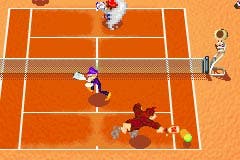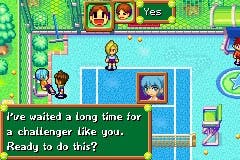Mario Power Tennis
Nintendo serves up another ace.
Tennis games are tennis games are tennis games, right? Well, not exactly. There's Virtua Tennis and Top Spin and a whole load of also-rans that most vaguely sane gamers steer well clear of. But Nintendo might have something to say about that, especially with the release of another charmingly quirky sports title featuring the ubiquitous tubby plumber.
As with every Nintendo sports title ever, the multi-talented cast of the Mario games makes its cheery appearance, but their role in this re-jigged GBA version has been diminished somewhat - and it's a much better, deeper game because of it. Although the game shares the same name as 2004's GameCube-exclusive, the structure's entirely different, featuring a much greater emphasis on the single player offering than the Cube version ever did.
Given that most of your handheld hours will be spent playing alone, the decision to include the Power Tour mode is a master-stroke, and becomes as compelling an addition to the tennis genre as we can remember. In what amounts to a Tennis RPG, you start off as a newcomer to the Royal Tennis Academy, with the basic idea to work your way up the singles and doubles ranks, with an eventual goal of becoming king of all you survey (much like the long-forgotten Game Boy Color Mario Tennis, in fact).
Shut up and play!

Initially, the non-stop incidental Zelda-esque chat can get on your nerves as you wander around the academy ("just let me play for the love of God! I don't care about the tennis academy restaurant!"). Even getting the first game underway can take ages, but eventually it strikes a nice balance between these fairly pointless interludes and action, letting you work your way up the junior, senior and varsity ranks at your own pace. Each rank has four challengers that you must defeat in turn before you can progress to the next set of opponents, and clearing the early encounters is pretty perfunctory.
At the end of each encounter the game rewards you with experience points, which can be distributed between four main parameters (Power, Control, Side Spin and Speed), while a further five sub-parameters (Serve, Stroke, Volley, Top Spin and Slice) can also be powered up every time you 'level up'. As you work your way up, you'll really start to notice the enhancements in your abilities, with shots being returned with more power and accuracy.
But gaining experience doesn't just come from defeating opponents; a plethora of Teaching Court tests and mini-games also give you crucial experience to help you put one over the numerous CPU opponents you end up facing. Ingeniously, the training tests really help you understand the principles that underpin the fundamentals of tennis, as well as giving you a handle on the controls. So, instead of being given patronisingly basic tuition, the advice given in improving service, net play, volleys and so on ends up giving you the kind of edge that you take with you into the matches themselves - plus you can level up your character into the bargain.
A mini adventure

Slightly more frivolously - but no less important in improving your character's stats - are the Training Centre tests, which comprise of eight hugely addictive mini-games that come in three levels of difficulty (with a score attack unlocked after that). Initially accessible only by wandering over to the Training Centre itself, the game kicks off with incredibly silly (but lovable) tasks such as the Treadmill (where you must run on a conveyor for a set distance while avoiding banana skins and barrels), or the Jump Gym (smash boxes before they get to the other side of the screen). Some of the latterly unlockable mini-games are so furiously addictive we spent literally hours slavishly completing them - notably the Duck Walk, where you must race to the finish line in a time limit while avoiding explosive panels, or how about the maddening Reflex Rally - a rock, paper, scissors reaction test that nearly drove us insane with obsessive-compulsive levels of addiction to crack the demented level 3.
Once unlocked, all the various training matches and mini-games become available on the main menu screen, allowing you to repeatedly play them and improve your character's stats in the process - while also serving as excellent bite-sized diversions that will melt away the most tedious commutes.
But essentially, the real task at hand is to qualify through the ranks and compete in the Island Open knockout tournament to decide the island's best player (or players if you decide to opt for the double challenge). But it doesn't end there. Up to that point, you're consistently left wondering when the 'real' opposition is going to show up - as in Mario and co. Entirely predictably, a further tournament with six of the Mario posse becomes your final challenge, with two rounds of five-setters to conquer before you finally can claim to be the best of the best. As single-player campaigns go, it’s a quality offering, and is as addictive a handheld tennis game as we can recall - and that includes the awesome Virtua Tennis.
Doing it for a reason

The key difference with Mario Power Tennis is the mini-games and training exercises feel much more justifiable than some of the oddball interludes you're forced to play in VT (and, indeed the Cube version of Power Tennis). In other words, the time you're not playing tennis is time well spent and is immensely satisfying. On the other hand, Camelot still hasn't quite nailed the overall gameplay brilliance, and the tennis experience on offer here doesn't quite give you that intuitive sense of total control over your shots. Oh, and it doesn't believe in the concept of shots being 'out', bizarrely.
As you may recall from the Cube original, it's basically Tennis with 'power shots' - which come in two flavours; defensive and offensive. To give it that essential Nintendo twist, a few shots into a rally your character becomes surrounded by what looks like a glittering target icon. At this point, you can hold down the right shoulder button and unleash a fearsome drive that's pretty tough to return - unless you're lucky enough to be in line with the shot. If it looks like you're out of range then you're probably out of luck and the point goes to your smug opponent. If, though, you too have a power shot at the ready, you can rescue the point with a defensive manoeuvre. Each of these is entirely ridiculous, of course, but come with their own special time-stopping animation and glitzy effects.
One of the side benefits of playing all those crazy mini-games in the single-player Power Tour mode is that you'll also unlock a stack of power shots into the bargain; allowing you to customise your character's abilities yet further and blast your opponents into next year.
Rally evolved

As such, Mario Power Tennis' rallies become more extensive as you go along, with each match becoming a strategic game of when's best to use your power shots. It's tennis, Jim, but not as we know it. Lacking the realism factor that defines its competitors, all that remains is whether it's as enjoyable. In the extensive Power Tour single-player mode, there's no question that it's a lot of fun, demanding something more than mere basic tennis knowledge, and is well worth checking out if you're a bit of a VT or Top Spin freak. It certainly kicks the underwhelming VT Advance into touch, and even gives VT World Tour a run for its money as a handheld game, but ultimately falls down by not really feeling quite right. The ball physics are a world away from being realistic, and the pace of the game doesn't really get going until you've really started to beef up your character.
You can, of course, ignore all of this and just play some basic Exhibition matches, but even then, the sense of speed is lacking (even at the top skill level with the unlockable 'star' versions of the Mario posse), and games quickly descend into power shot fests. Mercifully you can turn off power shots, but all that does is expose Mario Power Tennis for what it is - a great, but not brilliant tennis title.
Multiplayer-wise, the game's aided somewhat by being compatible with the Wireless adapter, but unlike the DS finding someone else with a copy of the game and the correct leads or hardware is the perennial issue. Still, if you're in luck then there is the potential for head to head or doubles encounters, but it's one hell of an expensive way of getting some multiplayer action (yes, it's one cartridge per player, sadly). If that's your thing, you could easily track down a GameCube and a copy of the original for a considerably smaller outlay.
As GBA titles go, Mario Power Tennis is a fantastic title to own - not least because it justifies its existence by being the best GBA tennis title by a mile. With a massively entertaining single-player element that features some mind-bogglingly addictive mini-games and excellent visuals it sells itself. It might not play the most incredible game of tennis you've ever come across, but that issue soon gets lost once you find out just how entertaining it is on the whole. Yet another shining example of the kind of simple, addictive brilliance that Nintendo seems to have a monopoly on these days.








